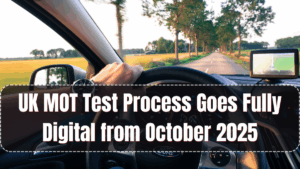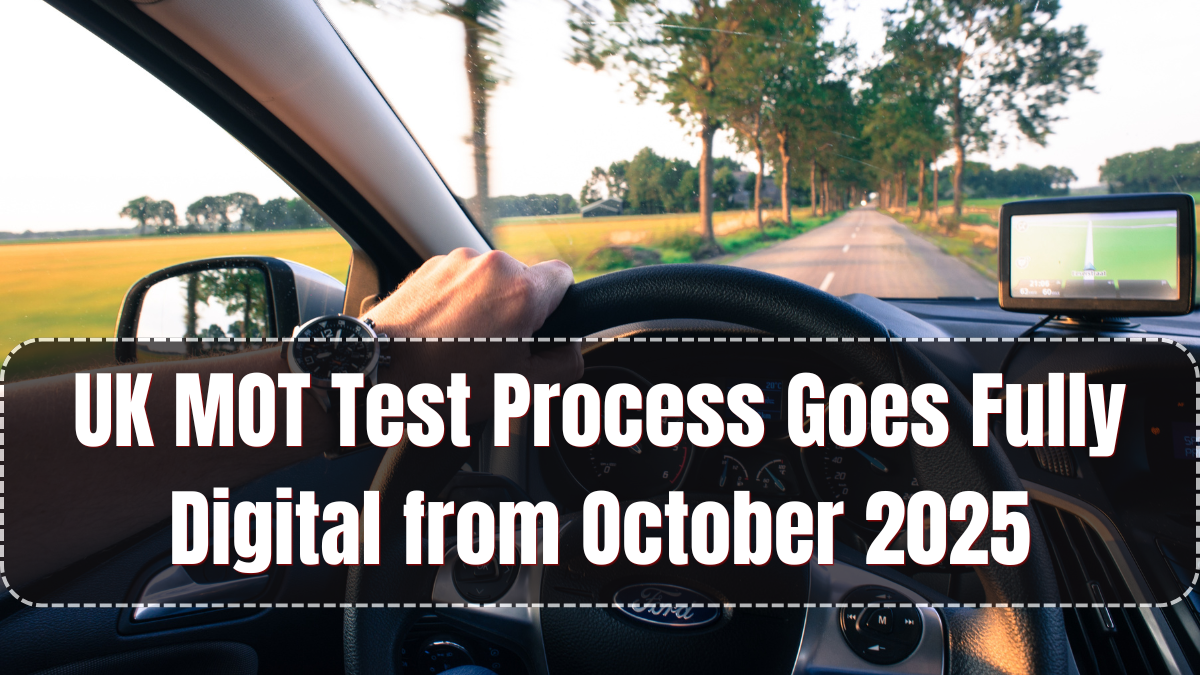The UK’s Driver and Vehicle Standards Agency (DVSA) has officially announced that the MOT test process will become entirely digital starting October 2025. This change comes as part of a broader effort to modernize road safety checks, improve efficiency, and reduce administrative delays for garages and motorists.
For car owners, this is a significant transformation that will affect how your vehicle’s MOT is booked, conducted, and recorded. Here’s everything you need to know about the digital shift and what it means for your annual vehicle inspection.

What is the MOT Test?
The MOT (Ministry of Transport) test is an annual inspection required in the UK for vehicles over three years old. It ensures that cars meet road safety and environmental standards. Without a valid MOT certificate, drivers face fines, penalty points, or worse—insurance invalidation.
Traditionally, MOT tests involved paper-based documentation, manual entries by testers, and physical MOT certificates. That system is now evolving into a completely digital format.
What Does ‘Fully Digital’ Mean?
The digital MOT system will eliminate most of the paperwork and allow all processes—including inspection details, failure reports, retests, and pass certificates—to be stored and transmitted electronically.
This will include:
-
Online test booking and appointment confirmations
-
Real-time upload of test results by garages
-
Digital signature capture for vehicle owners
-
Immediate issuance of e-certificates instead of paper MOT documents
-
Centralized database for MOT records accessible via GOV.UK
How Will This Change Affect Drivers?
Here’s what drivers need to be aware of when the digital MOT goes live:
-
No more physical MOT certificates: You won’t receive a printed copy unless specifically requested. All records will be accessible online.
-
Text and email notifications: Drivers will receive MOT reminders, test outcomes, and expiry alerts via SMS and email.
-
Digital tracking: Any vehicle’s MOT history can now be viewed instantly using the registration number. This increases transparency, especially during vehicle sales or resales.
-
Faster service: The removal of paperwork will reduce the time spent at testing stations.
Benefits for Garages and Testers
The digital rollout isn’t just beneficial to car owners—it streamlines the operations for garages and testers as well:
-
Automated logs: Testers no longer need to manually fill logs or print and store test outcomes.
-
Instant data validation: Digital systems will flag errors in real-time, reducing false entries.
-
Integrated retest workflows: Follow-up inspections will be scheduled and tracked online, reducing backlogs.
-
Performance analytics: Garages will have access to operational data that can help optimize services.
Government’s Vision Behind This Move
The DVSA’s goal is to create a smarter, greener, and more accountable vehicle testing system. The shift is expected to:
-
Enhance test accuracy
-
Reduce carbon footprint from paper usage
-
Support the UK’s goal of becoming a digital-first economy
-
Prevent MOT fraud and manipulation of test results
DVSA spokesperson Richard Blake stated, “Digitization is essential in a modern transport system. MOT reforms will ensure that our road safety checks are faster, more secure, and aligned with the UK’s tech future.”
Impact on Used Car Buyers
If you’re planning to buy a used car, this reform works in your favor. The digital MOT system will allow you to check the full MOT history of any vehicle in seconds through the DVSA portal. You’ll be able to:
-
Verify if a car passed or failed in previous years
-
Access mileage records and past advisories
-
Check upcoming test due dates
-
Avoid vehicles with suspicious test patterns or odometer rollbacks
Is This Mandatory?
Yes, starting from October 1, 2025, all MOT stations in the UK must adhere to the new digital protocol. Paper-based processing will be phased out completely. Car owners are encouraged to ensure that:
-
Their mobile numbers and email addresses are updated in vehicle records
-
They have access to GOV.UK’s online MOT checker tool
-
They request digital records if buying/selling a vehicle privately
Digital MOT vs Traditional MOT – Comparison Table
| Feature | Traditional MOT | Digital MOT (2025) |
|---|---|---|
| Certificate Format | Paper | Electronic (e-Certificate) |
| Booking Process | Phone/In-person | Online & App-based |
| Notifications | None or Paper Mail | Email & SMS Alerts |
| Result Entry by Testers | Manual | Real-Time Digital Entry |
| Access to Test History | Limited | Instant Online Access |
| Environmental Impact | High (Paper Use) | Low (Paperless Process) |
FAQs
What happens if I lose my MOT certificate after the digital update?
Since certificates will be issued digitally, you can re-download or access your MOT record anytime via the DVSA’s website using your car’s registration number.
Will I still be able to get a paper certificate?
Yes, but only upon request. The DVSA encourages all motorists to switch to digital records to minimize paperwork.
Is there any extra cost for the digital MOT?
No, the cost of the MOT test remains the same. The digitization is part of the DVSA’s modernization drive and comes at no added charge to car owners.
How can I check if my MOT is valid?
Visit the official GOV.UK MOT checker and enter your registration number. You’ll get real-time access to your MOT history and status.
Do older vehicles still qualify under the new system?
Yes. All vehicles over three years old, regardless of age or make, will be part of the digital MOT process. Testing standards remain the same.
